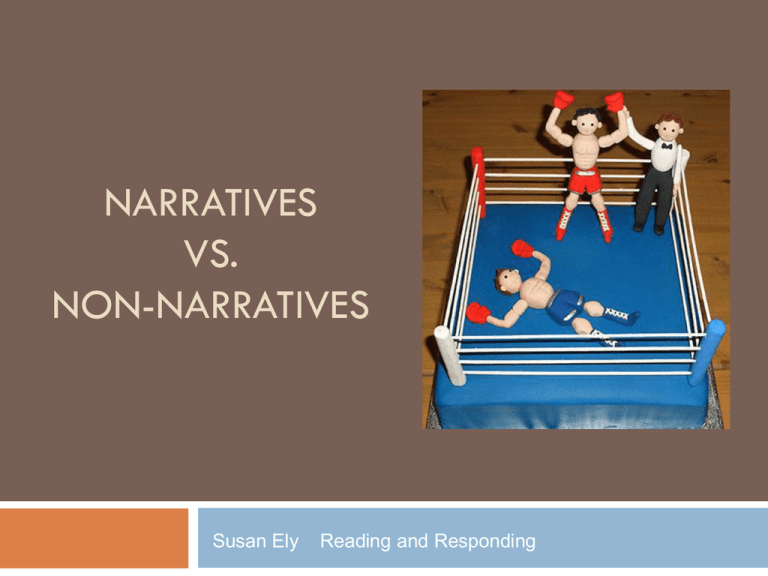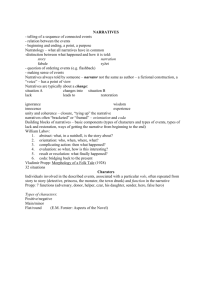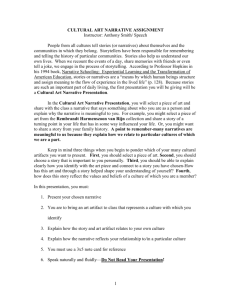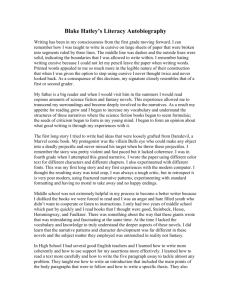Narratives_R_R
advertisement

NARRATIVES VS. NON-NARRATIVES Susan Ely Reading and Responding Narratives Use storyline in chronological order (time order) The point is what the writer or character learned from what happened Heavy on description, setting, plot and character Easy to visualize Non-Narratives Organized logically according to main ideas and details. Can use a variety of organizational patterns. The point is stated in the thesis statement (statement of purpose) Heavy on supporting reasons, evidence, research etc. Not so easy to visualize But….Sometimes we can use both A narrative used in a non-narrative piece for support Pg. 5, example 1.2 Introduction supporting reason Body supporting reason supporting reason Conclusion Why write narratives? Create shared history Entertain Spark curiosity Help us find meaning through real life events When used as support…. Narratives add human interest Narratives provide insight Narratives draw us closer to the writer/storyteller But….. Narratives used as support will most likely NOT be the main idea of the essay. Narrative I Event I Event I Event Non-Narrative I Support (cause/effect) I Support (compare) I Support (Narrative) I Support (Statistics/facts) So, what’s the point in knowing if I’m reading a narrative or not? “You have a better idea of how to read the assignment” (pg. 4) How is this true? You will know what to expect. So… It helps you preview (mapping where the reading will take you) because you know narratives use different comprehension clues If you are reading a narrative, there are ways to help you remember what you read General Narrative Structure Climactic Moment Rising Action (Tension) Falling Action (Reflection) C Introduction Background Setting Thesis Introduce Conflict o nc l u s i o n My Response Journal to “Fish Cheeks” by Amy Tan Pre-reading: Think of a time when your parents, siblings or other close relatives put you into a social situation that made you feel very uncomfortable or embarrassed. My Response Journal to “Fish Cheeks” by Amy Tan Setting Characters Beginning Event (or problem) Plot (or action) Outcome Personal Thoughts (what did you learning from the story)? Thesis Statements in Narratives main idea = (topic + meaning of the story) 2 ways a narrative’s main idea might be incorporated Explicit—directly articulates purpose of the story Implicit—does not directly state the purpose. Starts right into story and lets the details/images reveal the thesis. Example TOPIC: playing college football Example Implicit Thesis Statement for narrative: starts right into story and lets the details/images reveal the thesis Example Explicit Thesis Statement for narrative: My experience playing college football taught me skills that will benefit me throughout the rest of my life. Vocabulary Context (inference) People who worked with him were mickled by Rashid’s terrible job performance. A. disgusted B. delighted C. happy D. disowned Context (definition) The scientific experiment was not tortentous; even after performing the experiment repeatedly, Dr. Watson couldn’t tell whether the medicine was safe. A. available B. timely C. unclear D. conclusive Context (contrast) Instead of actively job hunting, Sunil was soddile; he figured the right job would come to him. Basic dictionary definition structure: Term Class Characteristics fork utensil two or more prongs A fork is a utensil that has two or more prongs. Basic dictionary definition structure: Term happiness ______Class feeling/emotion __Characteristics pleasure or enjoyment because of your life’s situation Happiness is a feeling of pleasure or enjoyment because of your life’s situation. Basic dictionary definition structure: Term ______Class _____Characteristics Leap to jump from a surface or over something Pounce to jump suddenly, going toward and take hold of something Vocabulary help Online Dictionaries like Webster: http://www.merriam-webster.com/ Quizlet: http://quizlet.com/ -Round 2- Topic vs. Main Idea Topic vs. Main Idea TOPIC Can be stated in a single word or phrase Not opinionated MAIN IDEA Stated in a complete sentence (in your own words) Expresses the writer’s opinion on the topic Also called _______ -Round 3- Skim vs. Scan Finding Main Idea Scanning- Looking down and around a page quickly and efficiently searching to find specific information (word/phrases). Search for: Key words Facts or phrases Finding Main Idea Skimming- Discovering main ideas by reading: 1st and last paragraphs topic sentences paying attention to Titles bold type or italics photographs captions Skim vs. Scan SCAN ● Comes before skimming ● Does it have info. I’m looking for? • Certain words • Certain phrases SKIM ● To quickly find details/main ideas ● Do 3-4 times faster than normal reading ● Reading a lot in a short amount of time ● Good when deciding if something is worth your time New York Times http://learning.blogs.nytimes.com/







